Abstract
The transition from reversible microscopic operator equations to irreversible equations for a deterministic density matrix is considered for examples of “simple systems”—the hydrogen atom or a free electron in an electromagnetic field. As a result of the transition, a system of a particle and field oscillators is replaced by a continuous medium. The Schrödinger equation for the deterministic wave function also describes the evolution of a continuum but without allowance for dissipative terms. In this sense, there is an analogy between the Schrödinger equation in quantum mechanics and Euler's equation in hydrodynamics. The smallest size of a “point” of a continuous medium is described by the classical electron radiusr e . It also determines the effective Thomson cross section for scattering of photons by free electrons. The lengthr e and the corresponding time interval τ e =r e /c play the role of “hidden parameters” in quantum mechanics. Two methods of calculating the effective Thomson cross section in terms of the extinction coefficient are considered. The first of them is based on the equation of motion of a free electron in a field with allowance for radiative friction. This equation leads to well-known difficulties. Moreover, the velocity fluctuations calculated on its basis lead to a contradiction with the second law of thermodynamics. The second method is based on the introduction of a constant friction coefficient Ń = τ −1e , the presence of which reflects loss of information on smoothing over the volume of a “point” of the continuous medium. Such a method of calculation leads to the same expression for the effective cross section but makes it possible to avoid the difficulties with the second law of thermodynamics. In the derivation of quantum kinetic equations, the physically infinitesimally small scales are determined by the Compton length λC and the corresponding time interval. The introduction of these scales makes it possible to separate and eliminate small-scale fluctuations, the “collision integrals” being expressed in terms of the correlation functions of these fluctuations.
Similar content being viewed by others
References
D. N. Zubarev,Nonequilibrium Statistical Thermodynamics, Plenum, New York (1974).
D. N. Zubarev, “Modern methods of the statistical theory of nonequilibrium processes,” in:Reviews of Science and Technology. Modern Problems of Mathematics, Vol. 15, VINITI, Moscow (1980), p. 131.
D. N. Zubarev and V. G. Morozov,Statistical Mechanics of Nonequilibrium Processes, Springer-Verlag (in press).
I. Prigogine,From Being to Becoming, W. H. Freeman and Co., San Francisco (1980).
I. Prigogine and I. Stengers,Order out of Chaos: Man's New Dialogue with Nature, Fontana, London (1985).
I. Prigogine,From Classical Chaos to Quantum Chaos [Russian translation], Priroda, Moscow (1993).
Yu. L. Klimontovich, “Nonequilibrium fluctuations in gases,”Teor. Mat. Fiz.,63, 1352 (1971).
Yu. L. Klimontovich, “Kinetic equations for a nonideal gas and nonideal plasma,”Usp. Fiz. Nauk,110, 537 (1975). (Published as a book by Nauka, Moscow, 1975.)
Yu. L. Klimontovich,Turbulent Motion and the Structure of Chaos [in Russian], Nauka, Moscow (1990); English translation published by Harwood Academic Publishers, Dordrecht (1991).
Yu. L. Klimontovich, “On the need for and the possibility of a unified description of kinetic and hydrodynamic processes,”Teor. Mat. Fiz.,92, 312 (1992).
Yu. L. Klimontovich, “From the Hamiltonian mechanics to continuous media. Dissipative structures. Criteria of self-organization,”Teor. Mat. Fiz.,96, No. 3 (1993).
Ya. P. Terletskii and A. A. Gusev (eds.),Problems of Causality in Quantum Mechanics [Russian translations], IL, Moscow (1955).
L. D. Landau and E. M. Lifshitz,The Classical Theory of Fields, 4th ed., Pergamon Press, Oxford (1975).
J. Sheffield,Plasma Scattering of Electromagnetic Radiation, Academic Press, New York (1975).
A. A. Sokolov, I. M. Ternov, V. Ch. Zhukovskii, and A. V. Borisov,Quantum Electrodynamics [in Russian], Moscow State University, Moscow (1983).
N. N. Bogolyubov and D. V. Shirkov,Quantum Fields [in Russian], Nauka, Moscow (1980).
V. B. Berestetskii, E. M. Lifshitz, and L. P. Pitaevskii,Quantum Electrodynamics [in Russian], Nauka, Moscow (1980).
Additional information
In memory of Dmitrii Nikolaevich Zubarev
Moscow State University. Translated from Teoreticheskaya i Matematicheskaya Fizika, Vol. 97, No. 1, pp. 3–26, October, 1993.
Rights and permissions
About this article
Cite this article
Klimontovich, Y.L. On the statistical derivation of the Schrödinger equation. Theor Math Phys 97, 1111–1125 (1993). https://doi.org/10.1007/BF01014804
Received:
Issue Date:
DOI: https://doi.org/10.1007/BF01014804




